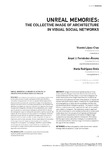Mostrar o rexistro simple do ítem
Unreal memories. The collective image of architecture in visual social networks
| dc.contributor.author | López-Chao, Vicente | |
| dc.contributor.author | Fernández-Álvarez, Ángel J. | |
| dc.contributor.author | Rodríguez-Grela, María | |
| dc.date.accessioned | 2023-11-09T10:34:01Z | |
| dc.date.available | 2023-11-09T10:34:01Z | |
| dc.date.issued | 2023-07-18 | |
| dc.identifier.citation | López-Chao, Vicente, Ángel J. Fernández-Álvarez, and María Rodríguez-Grela. (2023). “Unreal Memories: The Collective Image of Architecture in Visual Social Networks”. SOBRE. Publishing Practices in Arte and Architecture 9 (1):31-42. https://doi.org/10.30827/sobre.v9i1.27015. | es_ES |
| dc.identifier.issn | 2444-3484 | |
| dc.identifier.issn | 2387-1733 | |
| dc.identifier.uri | http://hdl.handle.net/2183/34123 | |
| dc.description.abstract | [Abstract] Images of architecture spread quickly on visual social networks that gain interest to disseminate and communicate architecture. For this reason, it is a must to diagnose the social construction of the image of architecture, to explore the restrictions and publication formats of the platform, to identify the reaction and dissemination habits in relation to the visual features of photography and to delve into the possibilities and the risks introduced by artificial intelligence systems. The research method follows a cognitive association approach through various graphic case studies on Instagram. The exploratory design to approach the role of the image to communicate architecture in visual social media arises from the concept of the fragment and the biased vision, a division required due to the nature of related image suggestions as a browsing method on Instagram. The findings identify opportunities and action strategies to complement the contents that build the collective image of architecture adapted to the logic of the new scenario. | es_ES |
| dc.description.abstract | [Resumen] Las imágenes de arquitectura se propagan rápidamente en las redes sociales visuales que ganan interés para difundir y comunicar la arquitectura. Por ello, es imprescindible diagnosticar el proceso de la construcción social de la imagen de la arquitectura, explorar las restricciones y formatos de publicación de la plataforma, identificar los hábitos de reacción y difusión con relación a los rasgos visuales de la fotografía y ahondar en las posibilidades y los riesgos que introducen los sistemas de inteligencia artificial (IA). El método de investigación sigue un enfoque de asociación cognitiva a través del análisis de varios estudios de casos gráficos en Instagram. El diseño exploratorio para abordar el papel de la imagen para comunicar la arquitectura en las redes sociales visuales surge del concepto de fragmento y de la visión sesgada, división requerida por la naturaleza de las sugerencias de imágenes relacionadas como método de navegación en Instagram. Los hallazgos identifican oportunidades y estrategias de acción para complementar los contenidos que construyen la imagen colectiva de la arquitectura adaptados a la lógica del nuevo escenario. | es_ES |
| dc.language.iso | eng | es_ES |
| dc.publisher | Editorial Universidad de Granada | es_ES |
| dc.relation.uri | https://doi.org/10.30827/sobre.v9i1.27015 | es_ES |
| dc.rights | Atribución-NoComercial-CompartirIgual 3.0 España | es_ES |
| dc.rights.uri | http://creativecommons.org/licenses/by-nc-sa/3.0/es/ | * |
| dc.subject | Architectural graphics | es_ES |
| dc.subject | Visual communication | es_ES |
| dc.subject | Built environment | es_ES |
| dc.subject | Cultural heritage | es_ES |
| dc.subject | Data visualization | es_ES |
| dc.subject | Comunicación visual | es_ES |
| dc.subject | Entorno construido | es_ES |
| dc.subject | Expresión gráfica arquitectónica | es_ES |
| dc.subject | Patrimonio cultural | es_ES |
| dc.subject | Visualización de datos | es_ES |
| dc.title | Unreal memories. The collective image of architecture in visual social networks | es_ES |
| dc.title.alternative | Unreal memories. La imagen colectiva de la arquitectura en redes sociales visuales | es_ES |
| dc.type | info:eu-repo/semantics/article | es_ES |
| dc.rights.access | info:eu-repo/semantics/openAccess | es_ES |
| UDC.journalTitle | SOBRE. Prácticas Editoriales en Arte y Arquitectura | es_ES |
| UDC.volume | 9 | es_ES |
| UDC.issue | 1 | es_ES |
| UDC.startPage | 31 | es_ES |
| UDC.endPage | 42 | es_ES |
Ficheiros no ítem
Este ítem aparece na(s) seguinte(s) colección(s)
-
GI-GIRAP - Artigos [44]






